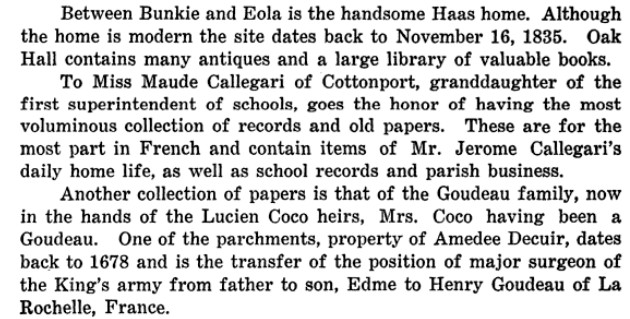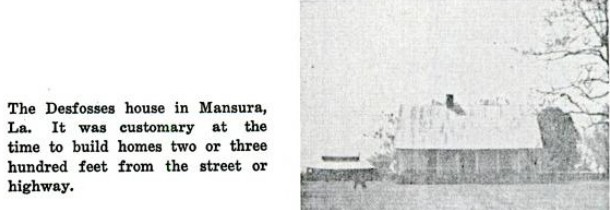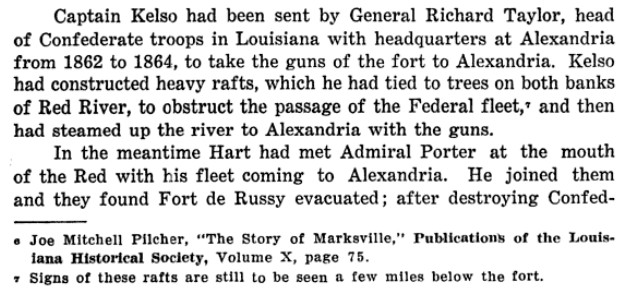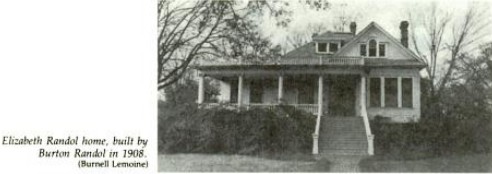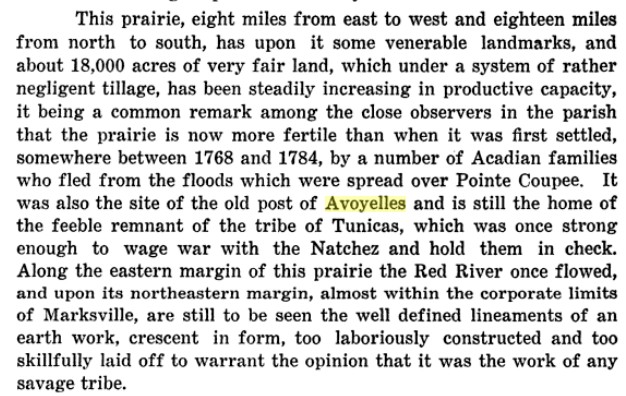Researching information about Simmesport, La., probably
an uninteresting place to most, I happened upon some interesting history,
if only to me.
if only to me.
Consider the following "yellow highlighted excerpts".
It's just a list of pertinent passages and a few pictures.
Maybe it will mature, maybe not.
It's just a list of pertinent passages and a few pictures.
Maybe it will mature, maybe not.
What I'm trying to do is to synchronize history book and personal recollection information
I have gathered from local people.
I have gathered from local people.
Both sources can have flaws.
This is La Commission des Avoyelles' version of the history of Avoyelles Parish
in their book, Avoyelles, Crossroads of Louisiana
I have no reason to doubt it. I am posting it, and excerpts from another book
as a guide. There will also be some railroad history which is exciting, I know.
I have no reason to doubt it. I am posting it, and excerpts from another book
as a guide. There will also be some railroad history which is exciting, I know.
First, just a few pictures to get you interested.
Update. I've run out of gas on this one so I will published it
without completion. I may continue later.
Update. I've run out of gas on this one so I will published it
without completion. I may continue later.
This one is an excellent start . I have heard Old Barney mentioned.
I don't know where, possibly in doing the Lejeune's piece or when I met Mr. Bearb.
This shot would have to have been in route.
The fish would be at Lacour's Ice House.
I know this one was at the end of Railroad Ave
I found the excerpt mentioning "Barney".
This is from the "History of Avoyelles Parish".
It is speaking of Long Bridge, where the rails from Bunkie split, one going to
Mansura and Marksville, and the other going to Simmesport and ultimately, Melville.
The station at Junction was in Bud's field.
This next shot was taken from the levee.
There is an air conditioner in the window. This would have to be in the 70's.
The depot, turntable and rails were gone.
You can see that the open ground is not rectangular, but opens up as it approaches the levee.
This was where the turntable was.
I have seen the little building. There were dogs going crazy so I didn't shoot it.
I will bring dog bones and make that attempt next time.
At this point I have no idea which book I gathered these quotes from.
I will chance fine and incarceration and present the information, as always.
A local historian spoke of Simmesport being at first "mostly just the Norwood Plantation".
The home below must be that of a descendant.
The L&A RR ran along La.1 connecting to Alexandria and Baton Rouge.
The T&P RR connected Baton Rouge to Bunkie and then Alexandria.
Along the way destinations south and southwest were reachable. Of course the Avoyelles Branch
through Simmesport departed from Bunkie.
The rail / automobile bridge across the Atchafalayac coincided with electrification.
Whether it was an influence or not, I can't say.

Yellow Bayou was the name of the skirmish.
Banks, with the help of Baily, once again forded a formidable river and escaped.
I should check the number on the symbol.
Notice "Norwood St".
Murphy Lacour and the Louisiana Ice and Utilities Co.
I am guessing he was a town hero.
He provided the facility that supported Simmesport's fishing industry.
This is Edenborn's rail and vehicle bridge over the Atchafalaya River at Simmesport.
This shot was taken from a very scary landing.
Below is an application for Lacour's building to be listed on the National Register.
Describe the present and original (if known) physical appearance.
{The building's picture is above}
Lacour's Fish and Ice Company Building (1927) is a single story brick galleried structure
located next to the Texas and Pacific railroad line on the north side of the small town of Simmesport.
The building has been altered very little over the years, and hence it retains its historical integrity.
The English bond brick structure has galleried loading docks on two sides. The main front is
distinguished by brick pilasters which protrude above the roofline and terminate in pediment shaped
granite caps. In addition, the slight parapet is trimmed with a granite cornice, The rear and sides of
the building are plain.
The plan consists of an engine room, an ice storage room, and a fish processing/ storage
room. Only the engine room has windows. The purpose of the engine room was to cool and pump
the ammonia refrigerant through a network of pipes which forms the ceilings in the other two rooms.
The pipes also form the shelves in a special boxed fish's storage area located in the fish
processing/storage room. The interior wall surfaces are coated with two inches of cork, most of
which remains in place. Virtually all of the original doors and doorways remain intact, as do the ice
chute and the original ice crushing machine.
Specific dates 1927
Builder/Architect Builders: Murphy Lacour and Louisiana Ice and Utilities Co.
Statement of Significance (in one paragraph)
Criterion A
The Lacour Fish and Ice Company Building is locally significant in the area of industry
because it was the center of a major industry in Simmesport in the late 1920's and early 1930's'*
The present structure was built in 1927 for Murphy L. Lacour, who is rightly regarded as the
founder of Simmesport's still thriving commercial fishing industry. Lacour had agreed to lease the
property from its owner, Louisiana Ice and Utilities Company, upon the construction of a building
which would serve as a fish packing storage and shipping facility for his fishing business. This
coincided with the completion in 1928 of the Edenborn railroad bridge over the Atchafalaya. This,
along with a railroad spur to the rear of the building, provided Lacour with the necessary
transportation facilities.
During the period under consideration (the late 1920's and early 1930's), agriculture and
commercial fishing were the two major industries in what was then a town with only a population of
around 600. Of these two employers, the commercial fishing industry was dominated by Lacour, who
operated the only fish packing plant in the town at the time.
The importance of Lacour's enterprise is evident if one looks at the volume handled and the
destinations of the shipments. The only extant shipping lists date from the fall of 1934, but it is safe
to assume that such a volume did not materialize overnight and that it can be projected backward to
the period under consideration (late 1920's and early 1930's), In addition, Lacour noted in interviews
later in his life that he was handling a comparable volume from the beginning. The shipping lists
reveal that Lacour was shipping on peak days anywhere from around 20,000 to 50,000 pounds of
fish to such places as New York, St. Louis, Little Rock, and Kansas City. Although employment
records do not exist, interviews with Lacour, his relatives, and men who worked with him indicate
that he employed around twenty-five people, which does not take into consideration the fishermen
from whom he obtained his fish. He had a fleet of several boats which plied the various rivers buying
fish to bring back to the plant.
Murphy Lacour oversaw operations at his fish packing plant until the early 1960's, after
which time various family members took charge. The structure was used as a fish packing plant until
the late 1970's.
The continuing importance of commercial fishing in Simmesport's economy is evident in the
numerous fish packing plants (all modern) which exist today and the nets lying in backyards. It is
estimated that the industry brings in about two million dollars annually. The Lacour Fish and Ice
Company Building is an important visual link with the beginnings of this ongoing business.
* This is the only period being considered because of the National Register 50 year cutoff for
significance.
Bibliography
Avoyelles Parish Conveyance Records.
Avoyelles Parish Vertical File, Louisiana State Library, Louisiana Division.
Barr, Hazel. Typescript history of Simmesport. Portion on Lacour based upon interviews with him.
Copy located in Simmesport vertical file at Louisiana State Library, Louisiana Division.
Coco, Wayne. Research report on Lacour's Fish and Ice company Building. Copy in National
Register file.
Eakin, Sue. Personal communication. Dr. Eakin teaches Louisiana history at LSU-Alexandria and is
an expert on central Louisiana history.
Eakin, Sue. "Simmesport, Murphy Lacour One in Same." Alexandria Daily Town Talk, September
25, 1977. Based on interview with Lacour.
La Commission des Avoyelles. Avoyelles Parish: Crossroads of Louisiana. Baton Rouge: Moran
Publishing Corporation, 1981.
Saucier, Corinne L. History of Avoyelles Parish, Louisiana. New Orleans Pelican Publishing
Company, 1943.
Shipping Lists, Simmesport Fish Company, September and October, 1934. In possession of Wayne
Coco.
Simmesport Vertical File, Louisiana State Library, Louisiana Division.
I'm going to go a little "out of town" and come back to Simmeport "strong", later.
This from "History of Avoyelles Parish".
Missing page.
More about Plaucheville, Dupont, Back Step and Choupique
from the "Cross Roads of La" book.
Missing page.
Edenborn and Naples
Moreauville
This may have been a rooming house.
The high Moreauville levee.























































































